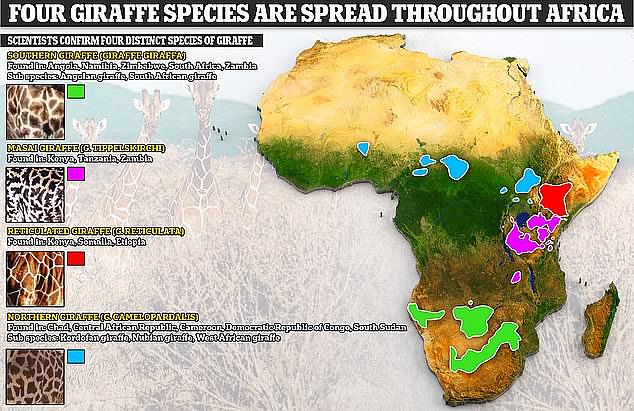It is undoubtedly one of the most majestic creatures in the animal kingdom.
But it turns out there’s not just one species of giraffe.
In fact, there are four.
Scientists from the International Union for Conservation of Nature (IUCN) have confirmed that the Northern Giraffe, Reticulated Giraffe, Masai Giraffe, and Southern Giraffe are distinct from one another.
Despite looking eerily similar, these species are actually as different as brown and polar bears!
Michael Brown, a researchers in Windhoek, Namibia, who led the assessment, explained: ‘Each species has different population sizes, threats and conservation needs. When you lump giraffes all together, it muddies the narrative.
‘Recognising these four species is vital not only for accurate IUCN Red List assessments, targeted conservation action and coordinated management across national borders.
‘The more precisely we understand giraffe taxonomy, the better equipped we are to assess their status and implement effective conservation strategies.’

Until now, the giraffe has been classified as a single species, with nine subspecies. However, the IUCN has now evaluated extensive genetic data – confirming that there are actually four distinct species

The Northern Giraffe (Giraffa camelopardalis) is found in Chad, Central African Republic, Cameroon, Democratic Republic of Congo, and South Sudan, and is known for its long and thin ossicones – the bony structures found on giraffes’ heads

The Southern Giraffe (Giraffa giraffa) lives in Angola, Namibia, Zimbabwe, South Africa, and Zambia
Until now, the giraffe has been classified as a single species, with nine subspecies.
However, the IUCN has now evaluated extensive genetic data – confirming that there are actually four distinct species.
These species can be found across the African continent.
The Northern Giraffe (Giraffa camelopardalis) is found in Chad, Central African Republic, Cameroon, Democratic Republic of Congo, and South Sudan, and is known for its long and thin ossicones – the bony structures found on giraffes’ heads.
The Reticulated Giraffe (Giraffa reticulata) lives in Kenya, Somalia, and Ethiopia, and is the largest of the four species – reaching impressive heights of up to six metres.
The Masai Giraffe (Giraffa tippelskirchi) is native to East Africa, with sightings in Kenya, Tanzania, and Zambia.
This species is known for the distinctive, leaf–like patterning on its fur.
Finally, as the name suggests, the Southern Giraffe (Giraffa giraffa) lives in Angola, Namibia, Zimbabwe, South Africa, and Zambia.

The Reticulated Giraffe (Giraffa reticulata) lives in Kenya, Somalia, and Ethiopia, and is the largest of the four species – reaching impressive heights of up to six metres

The Masai Giraffe (Giraffa tippelskirchi) is native to East Africa, with sightings in Kenya, Tanzania, and Zambia
This species is the most populous of the four.
Experts believe the four giraffe lineages began to evolve separately of each other between 230,000 and 370,000 years ago.
In the wild, the four different species do not mate, although conservationists have found it is possible to get the different species to mate under certain circumstances.
Read More
Heartbreaking photos show a giraffe with hundreds of skin lesions thanks to a rare viral disease

Sadly, the populations have declined sharply in the past century to around 117,000 wild giraffes throughout the African continent.
With four distinct species, it makes the situation worse, as each individual species is under even greater threat from rapidly declining numbers and a lack of intermixing.
‘We estimate that there are less than 6,000 northern giraffes remaining in the wild,’ Dr Julian Fennessy, director of the Giraffe Conservation Foundation, previously explained.
She added that ‘as a species, they are one of the most threatened large mammals in the world.’
